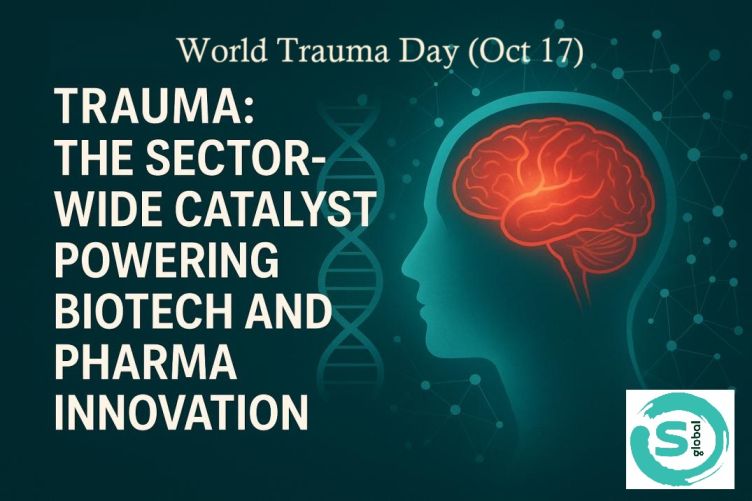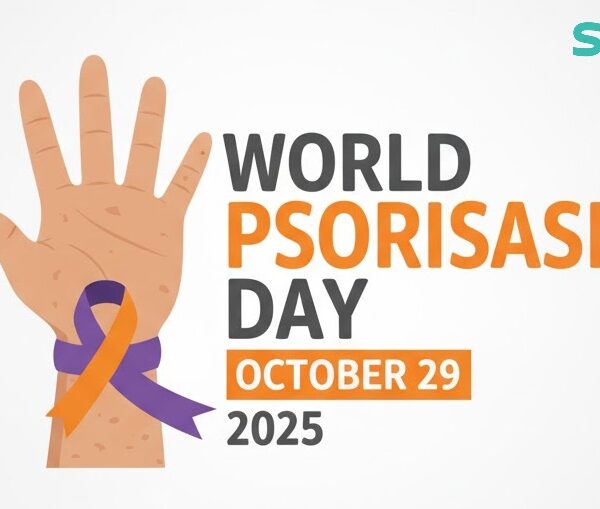- Saturo Global Research Services Team
- October 17, 2025
- Data Curation

Contributor: Rajalakshmi Venugopal, Associate Director – IP [Oct 2025]
Trauma: The Sector-Wide Catalyst Powering Biotech and Pharma Innovation
Opening With Real-World Momentum
As global researchers mark World Trauma Day 2025, a new wave of attention is directed toward molecular and clinical insights emerging from trauma research. Longitudinal studies—like Reli€ving-PTSD—are now unravelling how exposure to traumatic stress produces quantifiable changes in molecular markers, offering unprecedented opportunities for prevention, intervention, and innovation across life sciences. Industry experts and research leaders concur: “Advances in omics and longitudinal patient analysis are central to unlocking the secrets of trauma vulnerability and resilience,” according to published reviews in early 2025. This sector-wide attention is changing the pace and focus of drug development initiatives globally. [1]
Trauma’s Timely Relevance: Shaping Future Biotech R&D
Why This Matters for 2025
Trauma is no longer seen only as an acute clinical challenge—it has become a core lens through which disease vulnerability, progression, and resilience are investigated. Researchers now recognize that trauma exposure can create distinct molecular and genetic signatures in patients, directly informing future therapies and diagnostics. In the coming year, this understanding is expected to accelerate innovation, from biomarker-related discoveries to patient-centric data services across pharma, biotech, and clinical research. [1, 2, 3 & 5]
Drug Discovery: Molecular Biomarkers and Sectoral Innovation
Biotech R&D Trends
Leading R&D groups are working to identify blood-based markers and gene expression patterns linked to traumatic injury and stress adaptation, using omics approaches and longitudinal cohort analysis. [1, 5, 6 & 7] These efforts include:
- Transcriptome and miRNome studies: Detecting differentially regulated genes and microRNAs in recently traumatized patients, correlating these molecular signatures with future risk or resilience. [1 & 8]
- Emerging platforms: Multi-omics projects in trauma and stress research applying machine learning to large-scale clinical and molecular data. [1 & 2]
Major Organizational Trends
Many life sciences organizations—as noted in industry analyses—are broadly investing in biomarker discovery and molecular diagnostics related to trauma, often in partnership with leading academic and research institutes. While specific initiatives are difficult to attribute without direct, public references, recent healthcare sector reviews emphasize a widespread move toward trauma-informed innovation and patient stratification. [2, 9 & 10]
Paraphrased Insight
Clinical, regulatory, and commercial leaders underscore the importance of integrating patient history—including trauma events—into therapeutic targeting and personalized patient care strategies. Precision medicine and digital health are advancing in parallel, improving data curation in R&D pipelines and supporting the translation of scientific breakthroughs to clinical practice. [2, 9 & 11]
Preclinical Development: Data Diversity and Artificial Intelligence
Life Sciences Data Services
In preclinical settings, trauma research is expanding diversity in animal and patient models, enhancing validity and predictive power of drug testing. [1 & 2] Artificial intelligence and machine learning are now routinely applied to:
- Curate multimodal trauma datasets for translational studies.
- Predict patient outcomes using genetic, biomarker, and environmental data. [2 & 11]
This sectoral shift toward trauma-sensitive study design is widely documented in pharma trend reports, with leading organizations adopting next-generation data strategies to drive meaningful innovation. [2, 10 & 11]
Regulatory Strategy: Modernization and Compliance
Pharma Innovation and Global Regulatory Trends
Regulatory bodies across the US, EU, and India have updated guidelines to speed review timelines, enforce diverse patient recruitment, and require transparent, digital trial data—especially in studies involving trauma endpoints or stress-related pathologies: [3, 4, 12 & 13]
- Decentralized and real-world trial designs are encouraged, ensuring that trauma-impacted populations are included and outcomes accurately captured.[4]
- Compliance checklists: Tighter timeframes for trial registration and reporting, greater scrutiny on ethical standards, and digital harmonization globally. [3, 4 & 12]
Sector-wide, sponsors and R&D teams are investing in regulatory readiness and adaptive protocol design to align with modern expectations—an emerging best practice as noted in recent regulatory guides. [3, 12 & 14]
Manufacturing and Scale-Up: Digital Health and Data-Driven Quality
Technology Transfer & Manufacturing Innovation
Industry reviews highlight a growing emphasis on rapid technology transfer, digital manufacturing oversight, and integration of trauma-relevant safety/efficacy data in scale-up processes. Trends include: [2, 10 & 11]
- Automated lab technologies and smaller footprint instruments to support flexible production and immediate translational R&D.
- Use of AI-ready digital reporting for validation and compliance in manufacturing environments, adapting to trauma-informed therapy and device development. [2 & 11]
Industry Summary Table: Sectoral Trends
Area | Key Focus | Industry Example/Trend | Sector Evidence |
| Drug Discovery | Molecular biomarkers, omics profiling | Multi-omics, transcriptome analysis [1 & 2] | Literature review |
| Preclinical Development | Data diversity, predictive analytics | AI curation, multimodal cohorts [11 & 2] | Trend reports |
| Regulatory Strategy | Compliance, patient-centric trial design | Transparency, diversity mandates [3, 4 & 12] | Regulatory updates |
| Manufacturing & Scale-Up | Automation, digital health, quality modulation | Lab automation, AI-driven oversight. [2 & 11] | Industry guides |
Leading Organization Practices (Sector-Wide)
Reports cite broad investment in trauma biomarker research, omics-enabled platforms, and data privacy/protection enhancement among top pharma and biotech companies globally, without assigning specific initiatives to individual institutions. Collaborations with academic groups and tech-enabled data services are cited as driving sectoral progress in trauma-related discovery, trial design, and commercialization. [2, 9 & 10]
Partnerships for the Next Era
As trauma research evolves, so does the collaborative landscape of drug development—leveraging data-driven insight, cross-sectoral teamwork, and regulatory modernization. The coming years will see stronger partnerships between life science innovators, clinical researchers, and strategic data services. Their shared goal: to translate the latest biomarker discoveries and patient-centric strategies into therapies that heal both visible injuries and invisible scars, catalysing an era of profound progress in pharmaceuticals and global healthcare.
Saturo Global: Empowering Pharma and Life Sciences R&D
Data Curation, Indexing & Abstracting, Patent Support
Saturo Global stands at the intersection where trauma science and practical ingenuity meet. The team supports R&D units with:
- Data curation: Building trauma-sensitive databases that empower teams to glean actionable insights from historical, genomic, and patient-reported data. This enables pharma and biotech R&D teams to identify biomarkers, understand patient variability, and accelerate target discovery and precision medicine development for trauma-focused therapies.
- Indexing and abstracting: Delivering structured summaries on trauma research, clinical trial outcomes, and regulatory trends for rapid decision-making. By streamlining knowledge management, R&D professionals can design better experiments, stay aligned with regulatory updates, and gain a competitive advantage in trauma-focused drug development.
- Strategic patent support: Ensuring innovations—such as novel drug delivery systems targeting injury “signatures”—are protected through customized IP strategies tailored for trauma-linked therapies. Helping R&D teams to gain valuable insights into technology gaps, white spaces, and crowded areas in trauma-related therapeutic domains.
Saturo Global enables biotech and pharma companies to transform trauma from a liability into a source of competitive advantage, equipping teams to lead the next wave of human-centric innovation.
References:
- https://pmc.ncbi.nlm.nih.gov/articles/PMC12345373/
- https://www.simon-kucher.com/en/insights/healthcare-and-life-sciences-trends-2025
- https://prorelixresearch.com/2025-fdaaa-801-clinical-trial-rule-impact/
- https://realtime-eclinical.com/2025/01/14/regulatory-updates-in-clinical-trials-whats-new/
- https://pmc.ncbi.nlm.nih.gov/articles/PMC12434789/
- https://www.sciencedirect.com/science/article/pii/S1878875024020709
- https://dha.mil/News/2025/08/26/14/01/USARIEM-Researchers-Find-Potential-Genetic-Marker-for-Resilience
- https://www.sciencedirect.com/science/article/pii/S2666144625000024
- https://www.mantellassociates.com/top-5-trends-to-follow-in-the-life-science-and-pharmaceutical-industry/
- https://www.deloitte.com/us/en/insights/industry/health-care/life-sciences-and-health-care-industry-outlooks/2025-life-sciences-executive-outlook.html
- https://www.thermofisher.com/blog/life-in-the-lab/10-life-science-trends-to-watch-in-2024/
- https://prorelixresearch.com/global-clinical-trials-2025-regulatory-guides/
- https://clinicaltrialrisk.org/clinical-trial-design/clinical-trial-regulations-navigating-the-constraints/
- https://www.ema.europa.eu/en/documents/other/regulatory-science-research-needs-2025-update_en.pdf
Keywords:
#BiotechInnovation #TraumaResearch #PharmaRandD #PrecisionMedicine #PharmaPipeline #Omics #LifeSciences #DataCuration #DataValidation #Indexing #Abstracting #PatentSupport #Patents #PharmaceuticalPatents #IntellectualProperty #SaturoGlobal



